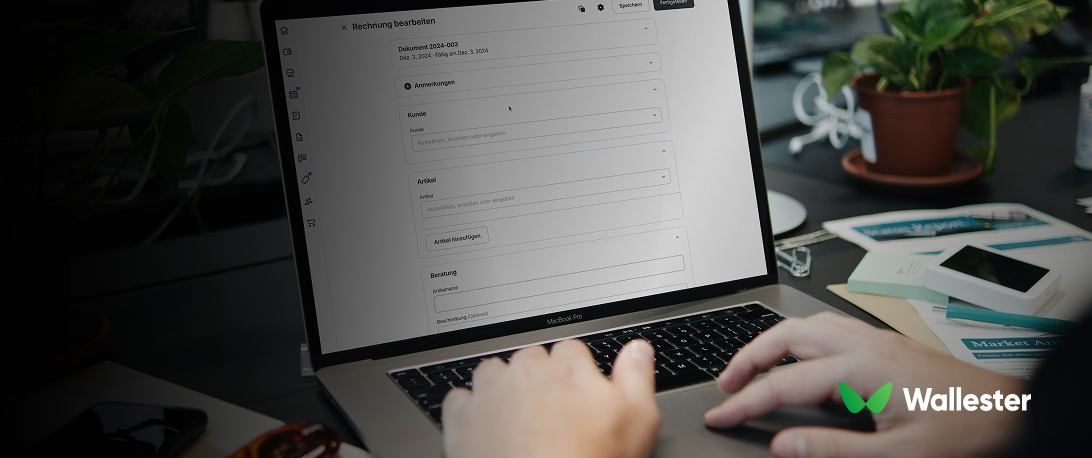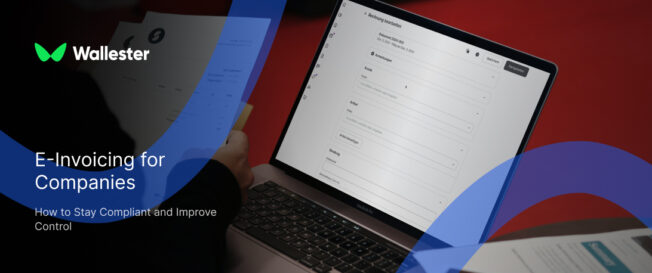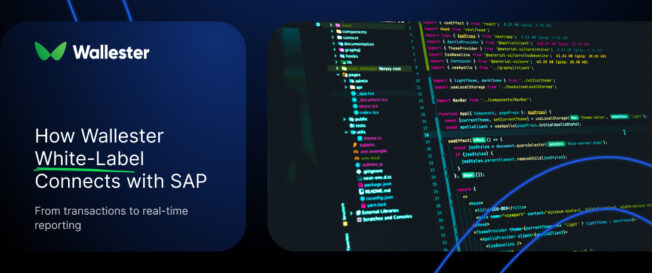Electronic invoicing has moved from a technical niche into a central part of modern financial operations. Governments in Europe and far beyond are turning it into a standard requirement, and companies see it as a way to bring clarity, accuracy and discipline to daily work. In July 2025 the European Commission published updated e-invoicing country factsheets for the European Union, confirming that digital invoice exchange with structured formats is an essential part of the economic agenda for the coming years.
This guide looks at e-invoicing in practical terms. You will find clear definitions, key differences from traditional billing, common standards, compliance points, and steps for real implementation. The aim is simple. Give finance teams a real understanding and a working plan.
What is e-invoicing?
E-invoicing means the creation, sending, receipt and storage of invoices in a structured electronic format that software can read without manual typing. A PDF is not e-invoicing in the regulatory sense. It may sit in an email or a folder, but someone still needs to check the amounts and type them into a system. A true e-invoice carries information in a structured data format such as XML or UBL. This allows automatic transmission between business systems and supports clear audit trails.
The purpose is digital convenience that makes invoice data reliable and ready for immediate processing in accounting and tax systems. Companies save time, avoid mistakes and support modern reporting rules.
Why are invoices important?
Invoices hold legal and financial value. They record the details of a supply, provide proof of payment obligations and support tax reporting. Without proper invoices a company cannot recognise revenue, claim expenses or justify VAT positions.
In everyday work invoices also guide cash flow planning. They connect procurement, budgets, payment terms and supplier control. A clear invoice process gives managers a consistent picture of who has asked for payment, when they should be paid and how that affects the balance sheet.
An invoice’s perception by tax administrations
For tax authorities, an invoice serves as a record between trading partners and as evidence of tax obligations. Authorities rely on invoices to confirm VAT amounts, taxable events and cross border supplies. That is why many jurisdictions support or require e-invoicing, electronic data interchange and structured data.
With structured formats, authorities can access invoice information almost instantly. It improves tax compliance, prevents VAT fraud and helps governments understand economic operators and trading flows. Some countries collect invoice information immediately as part of continuous transaction controls. Others ask for regular digital reporting and maintain secure networks to verify authenticity.
E-invoicing fits into this policy trend. Tax administrations want traceable, accurate and standardised invoice information that does not depend on manual data entry.
Further Reading: Expense Accounts Explained
What are the differences between e-invoices and traditional invoices?
Traditional paper invoices and PDFs are static documents. They require reading, checking and typing. E-invoices contain structured data that travels directly between business systems. Information such as amounts, supplier details, tax rates and payment instructions moves into ERP systems without human input.
Key distinctions:
- Traditional paper invoices need physical handling.
- PDFs often face spam filters or get lost in inboxes.
- True e-invoices use a structured format.
- E-invoices support tax requirements and continuous transaction controls.
- Processing status becomes visible in real time.
- Data entry errors become rare because data input happens automatically.
The shift is fundamental. It changes the role of finance teams from data processors to supervisors of clean, verified invoice flows.
How can you tell if an invoice is electronic or not?
A real e-invoice has structured data and is created in an electronic format designed for automated processing. A file that only looks digital is not enough.
To check, ask these questions:
- Can a system extract invoice information automatically without typing?
- Is the invoice format compliant with recognised standards?
- Does it travel securely between the supplier and the customer’s system?
- Can the document support future audits in a consistent format?
If the answer to any of these questions is no, then it is not a complete e-invoice.
What is the process of e-invoicing?
An e-invoicing flow usually looks like this:
- Supplier issues an invoice in structured format.
- The system validates fields such as tax amounts, supplier identity and invoice data.
- Invoice travels through secure networks or a central platform.
- The customer’s system receives the invoice electronically.
- Data lands in the ERP system.
- Approval workflow begins.
- Payment follows according to the company’s terms.
Throughout the process every step leaves a trace. That helps audits and supports compliance standards.
The benefits of e-invoicing
E-invoicing brings practical gains in day-to-day work.
- Less manual data entry and fewer data entry errors.
- Fast invoice reception and clear tracking.
- More reliable transaction data.
- Better alignment with tax systems and digital reporting requirements.
- Easier access to invoice information for finance teams.
- Lower reliance on paper invoices and postal delivery.
- Clear support for audit checks and long-term storage.
Finance teams get time back. Suppliers see reliable payment cycles. Management gains financial transparency and simple access to invoice information.

Limitations of e-invoicing
The move to e-invoicing requires preparation. Common challenges include:
- Supplier onboarding takes effort.
- Technical integration with ERP systems needs planning.
- Some small suppliers may not have compatible tools.
- Migration from paper invoices or PDFs takes time.
- Staff must learn new workflows.
Typical e-invoicing formats and standards
Businesses must use recognised formats to guarantee compatibility. Common structured formats include:
- XML and other extensible markup language standards
- UBL
- UN/EDIFACT
- PEPPOL BIS format for cross border transactions in the European Union
The choice depends on jurisdiction, industry and system capability. Structured data formats support automated e-invoicing and help meet tax requirements.
Further Reading: Role-Based Cards for Software and Tools
How does e-archiving work?
E-archiving stores electronic invoices in secure systems for the legally required period.
A proper archive keeps original invoice structure intact, protects data from alteration and allows clear retrieval. Many jurisdictions require electronic storage for several years. Companies must protect invoice information, maintain processing status records and respond to audits without delay.
Good archiving makes future reviews painless. Finance teams can find credit notes, original invoice records and other documents quickly without searching through folders.
What does PEPPOL stand for?
PEPPOL stands for Pan-European Public Procurement Online. It originally supported public procurement but is now widely used for B2B invoicing.
PEPPOL provides secure networks, common standards and a framework for exchanging invoices across borders. Companies and public bodies in many jurisdictions rely on PEPPOL for structured electronic processing and reliable data exchange.
How does e-invoicing work on a B2B, B2C and B2G level?
The core principles stay the same, but recipient type affects obligations.
- B2B: Businesses exchange structured invoices directly or through a network.
- B2C: Consumers receive simplified information, but the seller still keeps structured invoice data internally.
- B2G: Governments often require structured e-invoicing as mandatory for suppliers in public contracts.
Public procurement rules pushed many companies to adopt e-invoicing first. The private sector now follows as part of wider modernisation.
Are e-invoices mandatory?
In many countries e-invoicing mandates already exist. Mandates often begin with public procurement and then expand to business-to-business scenarios. Governments set deadlines for the ability to receive electronic invoices and later require issuing them as well.
The European Union supports a consistent framework for member states and encourages mandatory e-invoicing in line with VAT in the Digital Age plans.
Companies trading internationally should monitor rules in all relevant jurisdictions to avoid late compliance.
Further Reading: Turnover vs Profit: The Key Differences
Meeting e-invoice, e-document and CTC compliance requirements and conditions
To stay compliant companies need:
- Recognition of accepted formats.
- Validation procedures.
- Tools for secure transmission.
- Systems for real time reporting when required.
- Evidence of authenticity and integrity.
- Archiving policies that meet rules.
Continuous transaction controls apply in some countries. They require invoice data to pass through tax authority systems or approved platforms before final acceptance.
Organisations should stay close to fiscal updates and consult guidance from governments and professional bodies.
What is Continuous Transaction Controls (CTC)?
Continuous transaction controls allow tax authorities to access transaction data at or near the moment of issue. Instead of waiting for VAT returns, authorities monitor invoice flows in real time.
This model helps prevent tax evasion and gives authorities confidence in declared figures.
CTC frameworks vary across jurisdictions. Some use a central platform. Others use certified service providers. Businesses must prepare early because last-minute adjustments rarely work well with core finance systems.
Further Reading: Wallester Business vs Payhawk: Which Business Payment Solution Is Right For You?
What is VAT in the Digital Age (ViDA)?
VAT in the Digital Age is an initiative of the European Union. It aims to modernise VAT reporting, improve transparency and support cross-border trade.
Key areas include e-invoicing mandates, digital reporting and better data exchange across the European Union. Companies trading in Europe should track ViDA developments because they affect invoice processes, transaction data and cross-border tax compliance.
How to implement e-invoicing?
Successful adoption requires clear stages.
- Assessment
Review current invoicing processes. Count volume, formats, cross border transactions and supplier profiles. Understand your existing business systems and ERP connections.
- Planning
Set measurable goals. Create a timeline. Define roles. Prioritise high volume suppliers or public sector partners.
- Technology
Select an e-invoicing platform that supports structured format, secure networks, and storage. Confirm integration paths with accounting systems.
- Supplier enablement
Communicate expectations. Offer guidance for electronic format setup. Build a simple onboarding flow.
- Pilot
Start with a controlled group before full rollout. Track invoice information accuracy, approval flow and error rates.
- Full deployment
Expand to all suppliers. Monitor adoption, exceptions and processing status.
- Review
Evaluate transaction data quality, audit results and performance improvements.
The evolution of e-invoicing
E-invoicing began in industries with high transaction volumes and long approval chains. Government adoption drove growth, especially in B2G. Today every sector explores automation. Retail, manufacturing, services and logistics see clear value. ViDA and similar programmes bring a common direction, while private organisations recognise that structured electronic processing improves long-term resilience.
Paper invoices remain in some cases, but the trend is steady. Businesses understand that paper and PDFs slow financial processes and make tax compliance harder.
Market developments reflect legislative change and technology maturity. Providers focus on integration, supplier onboarding, validation rules, and secure transmission. ERP vendors prepare built-in tools. Procurement systems add invoice modules. Banks, payment providers and fintech companies explore invoice data links to funding, early payment programmes and credit notes management.
Interest grows beyond Europe. Latin America pioneered real time reporting and CTC. Asia and Africa adopt structured systems to improve tax returns and support economic growth.
Further Reading: Invoice Factoring vs. Invoice Discounting: What’s the Difference?
Streamline e-invoicing with Wallester invoice management
Modern financial operations require clean invoice flows, spending visibility and strong internal control. Wallester supports organisations building a complete spend environment that connects cards, invoice information and real time reporting.
Wallester Business platform allows companies to receive invoices electronically, monitor status, link documents to spend records and store invoice information securely. Businesses can issue cards for employees, track supplier payments, and maintain clear approval flows in one environment.

Finance teams gain a single view of spending across projects and departments. Supplier onboarding becomes easier. The system supports compliance expectations and gives managers confidence that all the invoices in the system match real activity.
If you want to bring structure and clarity to invoicing, move away from manual work and build a finance stack that reflects the digital age, Wallester can assist you at each stage.


